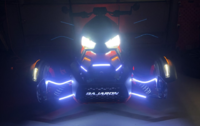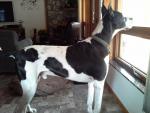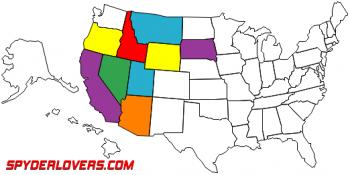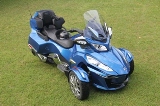|
-

 Originally Posted by Lew L

Thanks Ron and Peter,
I was curious as to how the VSS was influenced and you answer helped. Of course Pinky has brought up another point. A anti-roll bar transfers weight from the outer wheel to the inner right????
" But, generally, an antiroll bar transfers weight from the inside wheel to the outside wheel so it would encourage the lifting of the inside wheel ..." This statement doesn't " feel" right ( when ryding the  )
Lew L
Yes, well, that's what it does. In order to prevent the body rolling it adds to the spring rate on the outer wheel during a turn. It also reduces the spring rate on the inner wheel because it works against the suspension spring on that side. It's all a balance of forces, you don't get anything for nothing. An antiroll bar improves the handling but reduces the road holding at a given cornering speed because the outer wheel/tyre is under greater load. It's a plus/minus thing in suspension design and always a compromise. The functioning of the antiroll is such that it is sometimes working and other times not. There's good reason why road vehicles don't just employ massive antiroll bars so we can all just ride around nice a level! 
Rule#2: Never argue with an idiot. He'll drag you down to his level & then beat you with experience.
Rule#1: Refer to rule #2.
-
SpyderLovers Sponsor


 Originally Posted by PinkRosePetal

I understood about longitudinal and lateral acceleration but not roll. If indeed the sensor can measure roll or it is effected by roll (in a kinda positive way for us) then I can see how an antiroll bar can effect the VSS function. But, generally, an antiroll bar transfers weight from the inside wheel to the outside wheel so it would encourage the lifting of the inside wheel and invoke the VSS. If the VSS is less invoked on a bike fitted with an antiroll bar, as Bajaron suggests, then some other parameter(s) is coming into play when the bike stays more level in a turn. If roll measurement is a parameter considered by the VSS then it could certainly have an affect on the VSS's calculations.
This is actually the exact opposite of what an 'Anti-Sway Bar' does. We talk about 'Weight' being moved from one wheel to the other. But actually, a sway bar transfers energy (Down-Force) from the 'Heavy' outside wheel to the 'Light' inside wheel (and to a lesser extent, the rear wheel) in a turn. Since this essentially acts as a 'Weight' transfer. This is a good way to think about it.
When you go into a turn, down-force to the outside wheel is increased due to centrifugal force. The outside shock spring resists this force by pushing up on the body of the vehicle (against the lean). The hydraulic portion of the shock slows the velocity of the lean, and the sway bar does both. This works to DECREASE the amount of body lean.
At the same time, the inside shock spring is also pushing up on the body of the vehicle (with the lean), which actually works to make things worse by INCREASING the amount of lean. However, as body lean increases. The outside shock's ability to RESIST lean becomes greater, and the inside shock's ability to INCREASE lean becomes less. So the overall effect of the shock system works to decrease total lean. But shocks have no ability to transfer down-force.
The sway bar is simply a spring. A very stiff spring. It has no effect when there is no side force applied to the vehicle. This is why a Sway Bar cannot stiffen or make the ride harsh. Stiffening the shock springs will certainly do this. But not the sway bar. This is also why changing to a heavier sway bar cannot affect front end alignment.
A sway bar tries to maintain the same wheel height on both sides of the vehicle. When you go into a turn, the outside suspension is pressed down. The sway bar, attempting to maintain the same height on both sides of the vehicle, then transfers some of the excess down-force from the outside wheel to the inside wheel. Increasing the strength of the sway bar increases the amount of down-force transferred from the outside wheel to the inside wheel. This gives you a flatter ride in turns, increased traction at all 3 wheels, and REDUCES the possibility of the inside wheel lifting off of the ground. The harder the turn, the greater the down-force, the greater the energy transfer.
One more thing happens with a stronger sway bar. Because lean changes the front end alignment geometry. The more the lean, the greater the misalignment of the front tires. This misalignment causes you to have to adjust the turn angle (handlebar angle) several times in each turn as your Spyder oscillates from Under-Steer to Over-Steer. This is what wears you out on twisty roads. A stiffer sway bar will usually eliminate this oscillation. So not only is the Spyder easier to steer. It takes fewer (usually zero) adjustments after the initial turn-in to get your Spyder to go around a turn.
Great discussion! I'm sure I am boring at least some of you. I apologize for that. But it's fun to talk about it. When I started this Sway Bar project about 10 year ago, I thought it would be simple. After all. It's just a steel bar! But as usual. What you don't know can fill volumes. And I sure didn't know anything in the beginning. Except that I wanted my Spyder to handle better and feel safer than it did stock.
Last edited by BajaRon; 11-16-2019 at 01:34 PM.
Shop Ph: 423-609-7588 (M-F, 8-5, Eastern Time)
Only SLOW people have to leave on time...


-
Very Active Member

 Thanks Ron----- Thanks Ron-----
Thanks Ron,
You said it much more completely and clearly than I did. I've put on and enjoyed the result of stiffer anti-sway bars on a number of vehicles . Having more weight transferred to the inside wheel ( and less body roll) surely results in better and more sporty handling no matter if 3 or 4 wheels.
Lew L
Kaos----- Gone but not forgotten. 
2014 RTS in Circuit Yellow, farkle-ing addiction down to once every few months. ECU FLASH IS GREAT. 
-
Very Active Member


The Baja Ron swaybar gives me the perfect amount of improved cornering without messing up the comfort of my RTL. I find most suspension performance category upgrades involve heavy/heavier springing, which to me handles better but rides roughly. With the addition of the heavier sway bar I can corner more aggressively, yet the highway ride isn't compromised by the heavier springs of a performance shock setup. Win/win in my book. Doesn't handle quite as good a a full blown performance shock setup, but rides a whole lot smoother.
h0gr1der
2018 RT Limited Blue/Chrome SE6 *Tri-Axis Bars*Adjustable Driver Backrest*175/55R15 Vredestein Front, 205/60R15 Vredestein Rear Tires*Baja Ron Front Spring Pre-Load Adjusters*Misty Mountain Sheepskin seat cover*Centramatic balancers *Garmin Zumo 595LM GPS*KOTT Grills*BajaRon swaybar*SpyderPops Alignment*Missing Belt guard*Magnetic Mirrors*Custom Rear Adjustable Shock*360° LED Headlights & Foglights*Progressive front fender turn signals
States Visited on Less than 4 wheels.

-

BajaRon you've made a number of points but some of them are a bit diverse and don't actually relate to the anti-roll bar. I'm quite happy to discuss them too but for clarity I'll stick with the bar only for now.
 Originally Posted by BajaRon

This is actually the exact opposite of what an 'Anti-Sway Bar' does. We talk about 'Weight' being moved from one wheel to the other. But actually, a sway bar transfers energy (Down-Force) from the 'Heavy' outside wheel to the 'Light' inside wheel (and to a lesser extent, the rear wheel) in a turn. Since this essentially acts as a 'Weight' transfer. This is a good way to think about it.
No, this is not correct, you need to put your thinking cap on straight, BajaRon.
For simplicity I'm going to consider the arms of the bar as the levers and the central section as the torsion spring.
Also, you need to keep the principle of every action (force in our case) has an equal and opposite reaction - if in a static situation, a force pushes on something then that something pushes back with an equal force. eg. if a front tyre is on the road surface with a downward force of (say) 200lbs then the road is pushing up against the tyre with a force of 200lbs. If a chassis is pushing down on a spring with (say) 100lbs force then the spring is pushing the chassis up with a 100lbs force.
In the case of the anti-roll bar, the ends of its arms are tethered to the suspension and the ends of the torsion spring are tethered to both the chassis and the other end of the arms. The tethers are flexibly mounted but that is of no consequence for our purposes of discussion.
The height of the tethers at the suspension arms may or may not vary during operation dependent on the fixing point along the suspension arm length so, for simplicity, I'm going to consider it static.
So we all have the same vision, let's consider a view from the front of the vehicle with a side force on the vehicle body/chassis from the left-hand side of our view, above the body/chassis roll centre.
When the vehicle chassis pivots around its roll centre (with that force from the left side) the torsion spring section of the bar is forced to lean at an angle along with the chassis. Since it is tethered to its arms and the arms are tethered to the suspension the torsion spring is forced to twist. Relative to the torsion spring (important) the right arm pivots up and the left arm pivots down.
(Consider the right side of our imaginary vehicle diagram.) - This is because the road is pushing up on the tyre/wheel and they are joined to the suspension arm and the suspension arm is joined to the anti-roll bar arm. Because the road cannot move downward (is static) the reaction force will push up on the chassis and resist the chassis roll movement.
However, this can only happen because the other end of the anti-roll bar is also tethered to the left-hand suspension arm (in our diagram) which is similarly static but in this case the rolling of the chassis is trying to lift that suspension arm from the road surface.
It's by this means that the weight transfer occurs because the weight (force) which increases on the right-hand side is reduced by the same amount on the left-hand side.
If the side force increases, as it would if cornering faster, the load on the right side will increase and the load on the left side will decrease (Left and right relative to our imaginary diagram.) Ultimately, as the side force increases, there will come a point where the whole of the vehicle weight is transferred to the right side and then any further cornering force will cause the left wheel to lift off the road.
******************
The sway bar is simply a spring. A very stiff spring. It has no effect when there is no side force applied to the vehicle. This is why a Sway Bar cannot stiffen or make the ride harsh. Stiffening the shock springs will certainly do this. But not the sway bar.
This is also incorrect though it is almost correct for when the vehicle is stationary or moving over a glass smooth surface.
When the vehicle is moving over a glass smooth surface and there is no side force the suspension will not be operational, however, this is rarely, if ever, the case when moving on a road. The evenness/unevenness of the road surface will dictate the amount of interaction the anti-roll bar has on the spring rate of the suspension.
If the road surface is generally smooth but one wheel rises over a bump the bar will be forced to twist and, since it's a spring, will add to the vehicle suspension spring rate for that moment in time on that side.
If both wheels pass over an equal sized bump at the same time the bar will have no effect since it will simply pivot up on both sides an equal distance.
Since most roads, especially poor quality ones, are a a complex mixture of bumps and holes of varying degree the anti-roll bar will be working hard adding and subtracting from the spring rates in an unknown and constantly varying way. This is where it differs from a suspension road spring because a change of spring is a know quantity whereas an anti-roll bar is a variable spring dependent on the road surface.
Great discussion! I'm sure I am boring at least some of you. I apologize for that. But it's fun to talk about it.
You don't need to apologize for it, it's a big forum and can cater for our diverse interests....at least, I hope it can!
Rule#2: Never argue with an idiot. He'll drag you down to his level & then beat you with experience.
Rule#1: Refer to rule #2.
 Posting Permissions
Posting Permissions
- You may not post new threads
- You may not post replies
- You may not post attachments
- You may not edit your posts
-
Forum Rules
|





 )
)
 Reply With Quote
Reply With Quote




